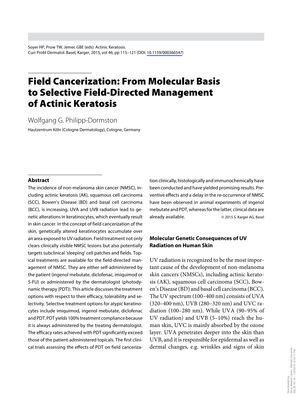Field Cancerization: From Molecular Basis to Selective Field-Directed Management of Actinic Keratosis
December 2014
in “
Current problems in dermatology
”

TLDR Photodynamic therapy is the preferred treatment for skin precancer due to its effectiveness and safety.
The document from 2014 examines the concept of field cancerization in skin cancer, particularly focusing on actinic keratosis (AK) and its management. It explains how UVA and UVB radiation can cause genetic changes in keratinocytes, leading to non-melanoma skin cancers (NMSC) such as AK, squamous cell carcinoma (SCC), Bowen's Disease (BD), and basal cell carcinoma (BCC). The paper reviews various treatments, highlighting photodynamic therapy (PDT) for its high compliance rate and effectiveness in treating both visible lesions and subclinical areas. PDT has shown promising results in clinical trials, including preventive effects and delaying NMSC recurrence. Other treatments like ingenol mebutate and diclofenac are also discussed, with ingenol mebutate reducing mutant p53 keratinocyte patches by about 70% in mice, and diclofenac achieving a 50% complete clearance rate of AK in humans after 90 days. The document concludes that PDT, ingenol mebutate, and diclofenac have demonstrated NMSC-delaying or preventive effects, with PDT being the preferred treatment for field cancerization due to its efficacy and safety profile.
